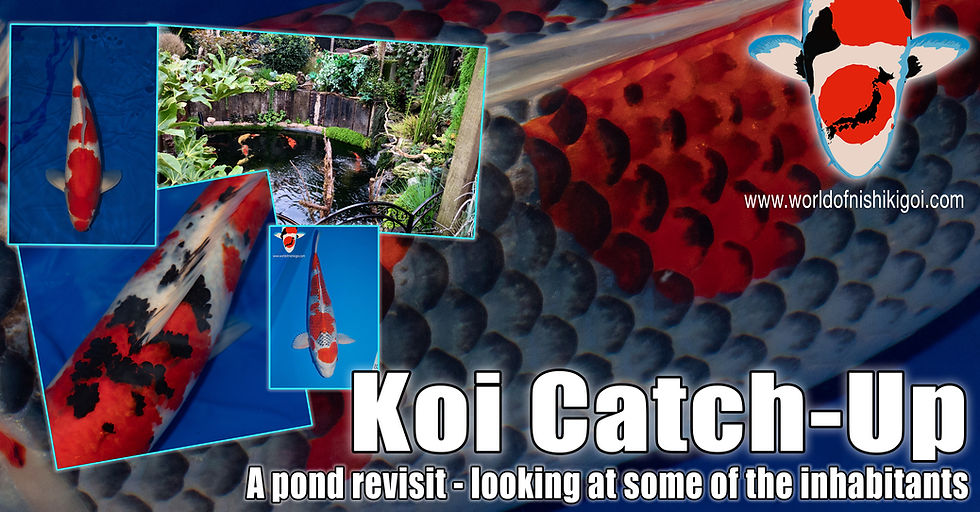
A while ago I featured the above pond owned by my friend Mark. At the time, due to the failing light (and far too much talking) we didn't get chance to bowl and photograph the koi.
Recently I popped back to take some snaps over a cuppa...or three...or was it four?
A little recap, Marks pond is about 1400gallons and is a pump-fed system that was originally designed to be an aesthetic addition to the garden. It was then altered and tweaked to make it 'koi-suitable.' It's a great accomplishment and represents a picture perfect smaller set up for those who like the water gardening aspect of the hobby.
Mark has quite a few specimens now spread between the main pond and a smaller system, on this occasion we took the chance to capture some of his favourite pieces.
Kujaku Then.

Mark purchased this kujaku in 2016, bred by Kaneko Koi Farm. If I remember correctly, three Kujaku were purchased as part of the box and whilst in Japan Kaneko had nodded to this as his preferred choice, he also suspected it to be female. Most importantly, Mark purchased it because Mark liked it!
Kujaku Now.




Well, she's definitely female! Now 65cm, she certainly makes an impact. Her body is typical of old-school kujaku, brootish! She'll never make a huge size and care must be taken in the coming years to manage her shape but I know Mark is over-the-moon with her. The beni has stayed strong and consistent, thickening with age. The matsubamon (pinecone pattern) wraps wonderfully down the flank of the koi, this is a very attractive attribute in Kujaku helping to highlight good scalation. In some examples the matsubamon can sit rather high, sometimes ending before the lateral line. Look at the third shot here, it wraps almost to the under-belly, meaning however you view her in the pond you can always appreciate the matsubamon and scalation! Interesting to note how the smudge on the side of the face (above the eye), never disappeared... but for the money paid, you can't have it all!
Kohaku Then.
Next up is a Kohaku bred at Byer Koi Farm (UK). I picked this out for Mark as a 17cm tosai a couple of years back when I visited the farm. It subsequently spent a summer in my pond whilst Mark was getting on top of some filtration upgrades. He hadn't got any Kohaku at the time and specified a 'stepped pattern.' I picked this because I liked the skin, I liked the pattern, I liked the ojime and it fell in Marks budget. It left my pond at 36cm...
Kohaku Now.

Well, I have to say I had no idea what to expect from a Byer Kohaku, but the first thing that must be mentioned here is the beni, absolutely blinding. This is definitely a RED and white koi! Now 42cm it's continued to grow reasonably well in unheated waters. It's turned out male, but that's of little importance to Mark. The skin is still very pleasing, the strong flawless beni sitting proudly in a very attractive pattern. Yes, it wraps down past the eye, which some might find off-putting but at least we know it's not been cut! The kiwa (back edge of the red pattern) is developing well, it will be interesting to see what continues to happen. The sashi (front edge of the red pattern) is also very tidy, just a few areas left to tighten up as the koi ages. Fingers crossed.
Sanke.

Speaking of 'red...' this sanke from Matsunosuke is also one of Mark's favourites. He purchased this very inexpensive koi at 13cm and in time it has grown to 41cm in his pond. Looking at the koi for what it is, it still has some lovely attributes, the sumi is glossy, the beni is attractive and mostly consistent, the nice tail stop at the ojime balances well with the white nose. The koi demonstrates the very typical 'old-school' Matsunosuke shape, long and slender. I actually think the koi would have grown rather well in a heated environment, but the trade-off probably would have seen the quality suffer...
"What you gain on the swings, you lose on the roundabouts."
Side Note:
I always remember the late Peter Waddington talking about Matsunosuke's 'red' reds, 'black' blacks and 'white' whites being of huge popularity when he first started importing and selling koi from Japan. People in the UK having never seen such bright and contrasting colours. Peter actually stated that he was told it was down to the naturally high levels of spirulina in the water where the farm is located. This induces the intense vibrancy and early development of the colour. Perfect for koi that are to be sold, but for tategoi it can cause them to 'peak' too early and so Toshio's tategoi would actually be moved to Niigata in the spring to balance their development...

Finally, another of Mark's top picks is his Hi Utsuri, purchased from Gary at Gatwick Koi. Nearly 50cm now, this koi has stayed pretty clean for a variety that tend to look messier with every season that passes. Consistent colour, well consolidated sumi and a very pleasing pattern to boot. I'm not the biggest fan of this variety but I’m very interested to see this one next season, great value for money!
Final Thoughts
I think Mark's done a great job with his koi. An unheated, hard water, 1400gallon system with no bottom drain, sounds so far from ideal on paper, some would have told him to give up. But we must remember that koi keeping is a hobby for everyone and every hobbyist can have different aspirations, priorities and budgets.
Regardless of what they are, if you can create an environment for koi to stay happy, healthy and show signs of development year on year...you’re doing pretty well indeed!












Comments